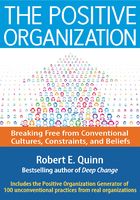
The Book
Your current organization is not static. It is continually becoming more negative or more positive. As organizations become more negative, the people within them tend to withdraw and underperform. As organizations become more positive, their people tend to invest and exceed individual and collective expectations.
The purpose of this book is to help create the second kind of organization. It not only illustrates how this is done in real organizations but also explains how to invite people to purpose, how to bring about authentic conversations, how to connect people to new possibilities, how to orient them to the common good, and how to facilitate the emergence of new, more positive cultures.
The appendix contains a useful tool called the Positive Organization Generator. It includes 100 positive practices from real organizations. It is designed so the reader can create new practices that can be implemented in any context without having to ask for permission from someone of higher authority.
At the end of each chapter, you will be asked to think about a key insight you gained and how it can help you to create a more positive organization. It is important to follow through on this, because it will help you envision the organization you want to create as you use the Positive Organization Generator.
There are also other tools for readers. At the end of chapters 3 through 7, there are assessments and activities you can use to introduce your unit or team to the concepts in this volume.
In the end, this book does two things. First, it introduces ideas designed to challenge your conventional assumptions. Second, it offers real tools and simple processes designed to support you in trying new things.
Deep learning can occur when both challenge and support are present. As you begin to conceptualize new practices and to see things from a more complex mental map, you will be able to transform yourself, your unit, and even your organization. If that happens, you and your people will never be the same. Your people will begin to flourish and exceed expectations. They will become fully engaged and continually renewed, and a more positive organization will emerge.
and a more positive organization will emerge.